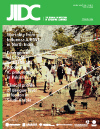Antimicrobial susceptibility and serovars of Salmonella from chickens and humans in Ibadan, Nigeria
DOI:
https://doi.org/10.3855/jidc.909Keywords:
Salmonella, Nigeria, antimicrobial resistance, human, chicken, bacteriaemia.Abstract
Background: This study determines the prevalence and antibiotic resistance of Salmonella serovars from humans and chickens in Ibadan, Nigeria, in 2004-2007.
Methodology: A total of 991 blood samples were collected from patients in 2004 to 2005 and 641 fecal samples were collected from poultry farms in 2007. All Salmonella isolates were serotyped and tested for antimicrobial susceptibility.
Results: Thirty-nine (4%) Salmonella isolates were obtained from human blood and 70 (11%) from chicken fecal samples. The human isolates revealed nine different serovars; 82% were non-typhoidal Salmonella and 18% were (S. Typhi). The majority of serovars from humans were S. Enteritidis (33%), S. Dublin (18%), and S. Typhimurium (18%). Resistance to chloramphenicol, sulfamethoxazole, trimethoprim, and ampicillin ranged from 36% to 59% for the human isolates.
Eight different serovars were obtained from chickens; S. Virchow (71%) predominated. A high frequency (87%) of reduced susceptibility to ciprofloxacin was observed among the chicken isolates. A high frequency of resistance to tetracycline (93%), nalidixic acid (81%), and sulfamethoxazole (87%) was observed. Rare serovars such as S. Apapa, S. Mouschaui, S. Jukestown, S. Oritamerin, and S. Onireke were isolated from both humans and chickens. Identical serovars were not found among human and chicken isolates.
Conclusions: This study indicates that chickens are not a reservoir of Salmonella causing bacteraemia among humans in Ibadan, Nigeria. Studies locating the reservoirs responsible for invasive salmonellosis in humans are needed. Controls and targeted interventions against S. Virchow and the frequent occurrence of antimicrobial resistance in chickens should be initiated to prevent the spread of this serovar.
Downloads
Published
How to Cite
Issue
Section
License
Authors who publish with this journal agree to the following terms:
- Authors retain copyright and grant the journal right of first publication with the work simultaneously licensed under a Creative Commons Attribution License that allows others to share the work with an acknowledgement of the work's authorship and initial publication in this journal.
- Authors are able to enter into separate, additional contractual arrangements for the non-exclusive distribution of the journal's published version of the work (e.g., post it to an institutional repository or publish it in a book), with an acknowledgement of its initial publication in this journal.
- Authors are permitted and encouraged to post their work online (e.g., in institutional repositories or on their website) prior to and during the submission process, as it can lead to productive exchanges, as well as earlier and greater citation of published work (See The Effect of Open Access).








